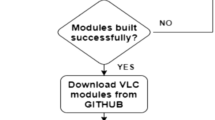Abstract
Various forms of wireless communications technologies have been proposed for intelligent transportation systems (ITSs). Recent events have illustrated that visible light communication (VLC) can play a significant role in achieving Vehicle-to-Vehicle (V2V) and Vehicle-to-Infrastructure (V2I) communication. Since it is energy efficient and available in abundance, it is in huge demand. Our prime objective of this experiment is to study the challenges that come during channel modulation and find optimal solutions to curb them. In this paper, we have done a comparative study of field of view (FOV) angles in different environmental conditions to evaluate the change in the signal-to-noise ratio (SNR). We performed a stress test on a previously laid model using NS 3.25 network simulator. This analytical approach helped us to successfully simulate SNR for different topological schemes and infer a hybrid model from it. Each topology scheme depicts a specific traffic scenario on the road.
Access this chapter
Tax calculation will be finalised at checkout
Purchases are for personal use only
Similar content being viewed by others
References
Demestichas P, Georgakopoulos A, Karvounas D, Tsagkaris K, Stavroulaki V, Jianmin L, Chunshan X, **g Y (2013) 5G on the horizon: key challenges for the radio- access network. Veh Technol Mag IEEE 8(3):47–53
Feng L, Hu RQ, Wang J, Xu P, Qian Y (2016) Applying VLC in 5G networks: architectures and key technologies. IEEE Netw 30(6):77–83
International Agency for Research on Cancer, World Health Organization, IARC (2011) Classifies radio frequency electromagnetic fields as possible carcinogenic to humans. In: Press Release No. 208, 31 May 2011
Cen N, Jagannath J, Moretti S, Guan Z, Melodia T (2019) LANET: visible-light ad hoc networks. Ad Hoc Netw 84:107–123
Rehman S, Ullah S, Chong P, Yongchareon S, Komosny D (2019) Visible light communication: a system perspective- overview and challenges. Sensors 19:1153
Mohan D, Tsimhoni O, Sivak, Flannagan MJ (2009) Road safety in India: challenges and opportunities. In: UMTRi-2009–1
O’Brien DC et al (2008) Visible light communication: challenges and possibilities. In: IEEE 19th International Symposium PIMRC, pp 1–5, Sept 2008
Ayyash M, Elgala HKA, Jungnickel Vlkerand Little T, Shao S, Rahaim M, Schulz D, Hilt J, Freund R (2016) Coexistence of WiFi and LiFi towards 5G: concepts, opportunities, and challenges. IEEE Commun Mag 54:64–71
Cui K, Chen G, Xu Z, Roberts RD (2010) Line-of-sight visible light communication system design and demonstration. In: 7th international symposium on communication systems, networks digital signal processing, pp 621–625
Yarkan S, Arslan H (2006) Identification of LOS and NLOS for wireless transmission. In: CROWNCOM, pp 1–5
Yang Y, Bagrodia R (2009) Evaluation of VANET-based advanced intelligent transportation systems. In: Proceedings of the sixth ACM international work-shop on Vehicular InterNETworking (VANET ’09). ACM, New York, pp 3–12
Ling Q, Baoshan L, Yongxing D (2019) Progress report on visible light communication in intelligent transportation environment. J Phys Confer Ser 1168:022050
Rajagopal S, Roberts RD, Lim S (2012) IEEE 802.15.7 visible light communication: modulation schemes and dimming support. IEEE Commun Mag 5:72–82
Singh B, Gupta A (2015) Recent trends in intelligent transportation systems: a review. J Trans Lit 9(2):30–34
Liu Q (2014) A study on topology in computer network. In: Proceedings 7th International Conference on Intelligent Computation Technology and Automation, ICICTA 2014, pp 45–48
Adnan-Quidan A, Morales-Cespedes M, Garcia-Armada A (2018) Aligning the light based on the network topology for visible light communications. In: IEEE international conference on communications workshops (ICC Workshops), pp 1–6
Pablo A (2017) Visible light communication networks under ring and tree topology constraints. J Comput Stan Interfaces 52:10–24
Network simulator 3 Homepage, https://www.nsnam.org. Last accessed 2019/11/30.
Aldalbahi A, Rahaim M, Khreishah A, Ayyash M, Ackerman R, Basuino J, Berreta W, Little T (2016) Extending ns3 to simulate visible light communication at network level. In: 23rd international conference on telecommunications (ICT), pp 1–6
Urachada K, Sermsak J, Yasuo K, Akira I, James R (2005) Channel modeling for optical wireless communication through dense fog. J Opt Netw 4:291–299
Author information
Authors and Affiliations
Corresponding author
Editor information
Editors and Affiliations
Rights and permissions
Copyright information
© 2021 The Editor(s) (if applicable) and The Author(s), under exclusive license to Springer Nature Singapore Pte Ltd.
About this paper
Cite this paper
Maheshwari, R., Grover, J., Mishra, S. (2021). Investigation of SNR in VLC-Based Intelligent Transportation System Under Environmental Disturbances. In: Marriwala, N., Tripathi, C.C., Kumar, D., Jain, S. (eds) Mobile Radio Communications and 5G Networks. Lecture Notes in Networks and Systems, vol 140. Springer, Singapore. https://doi.org/10.1007/978-981-15-7130-5_4
Download citation
DOI: https://doi.org/10.1007/978-981-15-7130-5_4
Published:
Publisher Name: Springer, Singapore
Print ISBN: 978-981-15-7129-9
Online ISBN: 978-981-15-7130-5
eBook Packages: EngineeringEngineering (R0)




